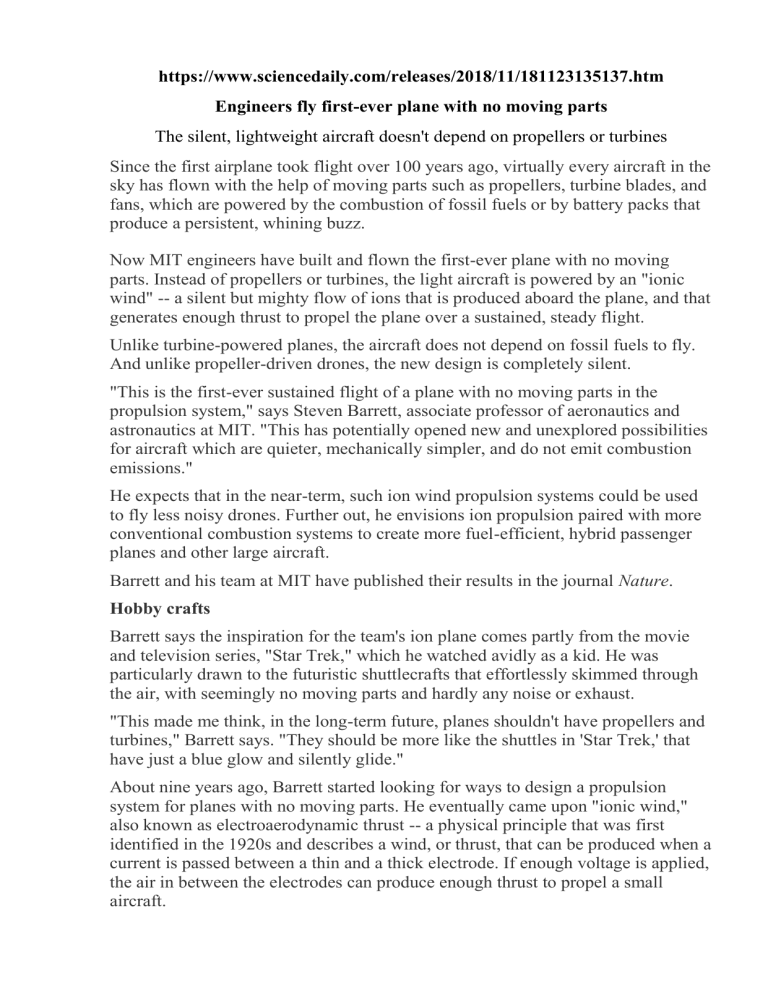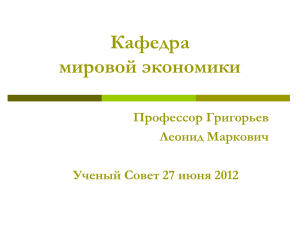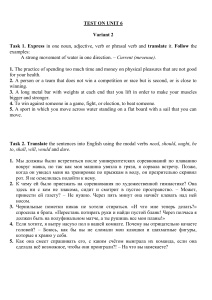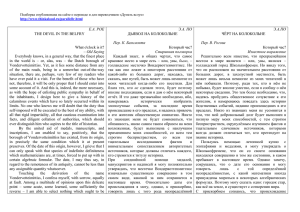
https://www.sciencedaily.com/releases/2018/11/181123135137.htm Engineers fly first-ever plane with no moving parts The silent, lightweight aircraft doesn't depend on propellers or turbines Since the first airplane took flight over 100 years ago, virtually every aircraft in the sky has flown with the help of moving parts such as propellers, turbine blades, and fans, which are powered by the combustion of fossil fuels or by battery packs that produce a persistent, whining buzz. Now MIT engineers have built and flown the first-ever plane with no moving parts. Instead of propellers or turbines, the light aircraft is powered by an "ionic wind" -- a silent but mighty flow of ions that is produced aboard the plane, and that generates enough thrust to propel the plane over a sustained, steady flight. Unlike turbine-powered planes, the aircraft does not depend on fossil fuels to fly. And unlike propeller-driven drones, the new design is completely silent. "This is the first-ever sustained flight of a plane with no moving parts in the propulsion system," says Steven Barrett, associate professor of aeronautics and astronautics at MIT. "This has potentially opened new and unexplored possibilities for aircraft which are quieter, mechanically simpler, and do not emit combustion emissions." He expects that in the near-term, such ion wind propulsion systems could be used to fly less noisy drones. Further out, he envisions ion propulsion paired with more conventional combustion systems to create more fuel-efficient, hybrid passenger planes and other large aircraft. Barrett and his team at MIT have published their results in the journal Nature. Hobby crafts Barrett says the inspiration for the team's ion plane comes partly from the movie and television series, "Star Trek," which he watched avidly as a kid. He was particularly drawn to the futuristic shuttlecrafts that effortlessly skimmed through the air, with seemingly no moving parts and hardly any noise or exhaust. "This made me think, in the long-term future, planes shouldn't have propellers and turbines," Barrett says. "They should be more like the shuttles in 'Star Trek,' that have just a blue glow and silently glide." About nine years ago, Barrett started looking for ways to design a propulsion system for planes with no moving parts. He eventually came upon "ionic wind," also known as electroaerodynamic thrust -- a physical principle that was first identified in the 1920s and describes a wind, or thrust, that can be produced when a current is passed between a thin and a thick electrode. If enough voltage is applied, the air in between the electrodes can produce enough thrust to propel a small aircraft. For years, electroaerodynamic thrust has mostly been a hobbyist's project, and designs have for the most part been limited to small, desktop "lifters" tethered to large voltage supplies that create just enough wind for a small craft to hover briefly in the air. It was largely assumed that it would be impossible to produce enough ionic wind to propel a larger aircraft over a sustained flight. "It was a sleepless night in a hotel when I was jet-lagged, and I was thinking about this and started searching for ways it could be done," he recalls. "I did some backof-the-envelope calculations and found that, yes, it might become a viable propulsion system," Barrett says. "And it turned out it needed many years of work to get from that to a first test flight." Ions take flight The team's final design resembles a large, lightweight glider. The aircraft, which weighs about 5 pounds and has a 5-meter wingspan, carries an array of thin wires, which are strung like horizontal fencing along and beneath the front end of the plane's wing. The wires act as positively charged electrodes, while similarly arranged thicker wires, running along the back end of the plane's wing, serve as negative electrodes. The fuselage of the plane holds a stack of lithium-polymer batteries. Barrett's ion plane team included members of Professor David Perreault's Power Electronics Research Group in the Research Laboratory of Electronics, who designed a power supply that would convert the batteries' output to a sufficiently high voltage to propel the plane. In this way, the batteries supply electricity at 40,000 volts to positively charge the wires via a lightweight power converter. Once the wires are energized, they act to attract and strip away negatively charged electrons from the surrounding air molecules, like a giant magnet attracting iron filings. The air molecules that are left behind are newly ionized, and are in turn attracted to the negatively charged electrodes at the back of the plane. As the newly formed cloud of ions flows toward the negatively charged wires, each ion collides millions of times with other air molecules, creating a thrust that propels the aircraft forward. The team, which also included Lincoln Laboratory staff Thomas Sebastian and Mark Woolston, flew the plane in multiple test flights across the gymnasium in MIT's duPont Athletic Center -- the largest indoor space they could find to perform their experiments. The team flew the plane a distance of 60 meters (the maximum distance within the gym) and found the plane produced enough ionic thrust to sustain flight the entire time. They repeated the flight 10 times, with similar performance. "This was the simplest possible plane we could design that could prove the concept that an ion plane could fly," Barrett says. "It's still some way away from an aircraft that could perform a useful mission. It needs to be more efficient, fly for longer, and fly outside." Barrett's team is working on increasing the efficiency of their design, to produce more ionic wind with less voltage. The researchers are also hoping to increase the design's thrust density -- the amount of thrust generated per unit area. Currently, flying the team's lightweight plane requires a large area of electrodes, which essentially makes up the plane's propulsion system. Ideally, Barrett would like to design an aircraft with no visible propulsion system or separate controls surfaces such as rudders and elevators. "It took a long time to get here," Barrett says. "Going from the basic principle to something that actually flies was a long journey of characterizing the physics, then coming up with the design and making it work. Now the possibilities for this kind of propulsion system are viable." This research was supported, in part, by MIT Lincoln Laboratory Autonomous Systems Line, the Professor Amar G. Bose Research Grant, and the SingaporeMIT Alliance for Research and Technology (SMART). The work was also funded through the Charles Stark Draper and Leonardo career development chairs at MIT. С тех пор как первый самолет поднялся в воздух более 100 лет назад, практически каждый летательный аппарат в небе летал с помощью движущихся частей, таких как пропеллеры, лопасти турбин и вентиляторы, которые приводятся в действие за счет сжигания ископаемого топлива или аккумуляторных батарей, издающих постоянный, ноющий гул. Теперь инженеры Массачусетского технологического института построили и запустили первый в мире самолет без движущихся частей. Вместо пропеллеров или турбин легкий самолет приводится в действие "ионным ветром" - бесшумным, но мощным потоком ионов, который создается на борту самолета и создает достаточную тягу, чтобы поддерживать самолет в устойчивом, устойчивом полете. В отличие от самолетов с турбинным двигателем, полет этого самолета не зависит от ископаемого топлива. И в отличие от беспилотных летательных аппаратов с пропеллерным приводом, новая конструкция абсолютно бесшумна. "Это первый в истории устойчивый полет самолета без движущихся частей в двигательной установке", - говорит Стивен Барретт, адъюнкт-профессор аэронавтики и астронавтики Массачусетского технологического института. "Это потенциально открыло новые и неизведанные возможности для самолетов, которые являются более тихими, механически более простыми и не выделяют вредных веществ при горении". Он ожидает, что в ближайшей перспективе такие ионные ветровые двигательные установки можно будет использовать для полетов менее шумных беспилотных летательных аппаратов. В дальнейшем он предполагает использование ионных двигателей в сочетании с более традиционными системами сгорания для создания более экономичных гибридных пассажирских самолетов и других крупных самолетов. Барретт и его команда из Массачусетского технологического института опубликовали свои результаты в журнале Nature. Хобби ремесла Барретт говорит, что вдохновение для создания ионного самолета команды частично пришло из фильма и телесериала "Звездный путь", которые он жадно смотрел в детстве. Его особенно привлекли футуристические шаттлы, которые легко скользили по воздуху, казалось бы, без движущихся частей и почти без шума или выхлопа. "Это навело меня на мысль, что в долгосрочном будущем самолеты не должны иметь пропеллеров и турбин", - говорит Барретт. "Они должны быть больше похожи на шаттлы в "Звездном пути", которые имеют только голубое свечение и бесшумно скользят". Около девяти лет назад Барретт начал искать способы создания двигательной установки для самолетов без движущихся частей. В конце концов он наткнулся на "ионный ветер", также известный как электроаэродинамическая тяга - физический принцип, который был впервые выявлен в 1920-х годах и описывает ветер, или тягу, которая может создаваться при пропускании тока между тонким и толстым электродом. Если подать достаточное напряжение, воздух между электродами может создать достаточную тягу, чтобы привести в движение небольшой самолет. В течение многих лет электроаэродинамическая тяга была в основном проектом любителя, и конструкции по большей части ограничивались небольшими настольными "подъемниками", привязанными к источникам питания с большим напряжением, которые создают ветер, достаточный для того, чтобы небольшой летательный аппарат ненадолго зависал в воздухе. В основном предполагалось, что будет невозможно создать достаточное количество ионного ветра, чтобы привести в движение более крупный самолет в течение длительного полета. "Это была бессонная ночь в отеле, когда я страдал от смены часовых поясов, и я думал об этом и начал искать способы, как это можно было бы сделать", вспоминает он. "Я провел некоторые предварительные расчеты и обнаружил, что да, это может стать жизнеспособной двигательной установкой", - говорит Барретт. "И оказалось, что потребовалось много лет работы, чтобы перейти от этого к первому испытательному полету". Ионы взлетают Окончательный дизайн команды напоминает большой, легкий планер. Самолет, который весит около 5 фунтов и имеет 5-метровый размах крыльев, несет множество тонких проводов, которые натянуты как горизонтальное ограждение вдоль и под передней частью крыла самолета. Провода действуют как положительно заряженные электроды, в то время как аналогично расположенные более толстые провода, идущие вдоль задней части крыла самолета, служат отрицательными электродами. В фюзеляже самолета находится стопка литий-полимерных батарей. В команду ионного самолета Барретта входили члены Исследовательской группы профессора Дэвида Перро по силовой электронике в Научно- исследовательской лаборатории электроники, которые разработали источник питания, который преобразовывал бы выходную мощность батарей в достаточно высокое напряжение для приведения самолета в движение. Таким образом, батареи подают электричество напряжением 40 000 вольт для положительной зарядки проводов с помощью легкого силового преобразователя. Как только на провода подается напряжение, они притягивают и отбирают отрицательно заряженные электроны у окружающих молекул воздуха, подобно гигантскому магниту, притягивающему железные опилки. Молекулы воздуха, которые остаются позади, вновь ионизируются и, в свою очередь, притягиваются к отрицательно заряженным электродам в задней части самолета. Когда вновь образовавшееся облако ионов течет к отрицательно заряженным проводам, каждый ион миллионы раз сталкивается с другими молекулами воздуха, создавая тягу, которая толкает самолет вперед. Команда, в которую также входили сотрудники лаборатории Линкольна Томас Себастьян и Марк Вулстон, провела на самолете несколько испытательных полетов над спортивным залом в спортивном центре Дюпон Массачусетского технологического института - самом большом помещении, которое они смогли найти для проведения своих экспериментов. Команда пролетела на самолете расстояние в 60 метров (максимальное расстояние в пределах спортзала) и обнаружила, что самолет производит достаточно ионной тяги, чтобы поддерживать полет все время. Они повторили полет 10 раз с аналогичными показателями. "Это был самый простой самолет, который мы могли спроектировать, который мог бы доказать концепцию того, что ионный самолет может летать", - говорит Барретт. "Это все еще довольно далеко от самолета, который мог бы выполнить полезную миссию. Он должен быть более эффективным, летать дольше и летать снаружи". Команда Барретта работает над повышением эффективности своей конструкции, чтобы производить больше ионного ветра при меньшем напряжении. Исследователи также надеются увеличить плотность тяги конструкции - количество тяги, создаваемой на единицу площади. В настоящее время для управления легким самолетом команды требуется большая площадь электродов, которые, по сути, составляют двигательную установку самолета. В идеале Барретт хотел бы спроектировать самолет без видимой двигательной установки или отдельных поверхностей управления, таких как рули и рули высоты. "Потребовалось много времени, чтобы добраться сюда", - говорит Барретт. "Переход от базового принципа к чему-то, что действительно летает, был долгим путем описания физики, затем разработки дизайна и приведения его в действие. Теперь возможности для такого рода двигательной установки вполне реальны". Это исследование было частично поддержано Линией автономных систем Лаборатории Линкольна Массачусетского технологического института, Исследовательским грантом профессора Амара Г. Бозе и Альянсом исследований и технологий Сингапура и Массачусетского технологического института (SMART). Работа также финансировалась через кафедры карьерного роста Чарльза Старка Дрейпера и Леонардо в Массачусетском технологическом институте. План: 1) Тew perspectives of aircraft 2) Hobby crafts 3) Hobby crafts Since the first airplane took flight over 100 years ago, virtually every aircraft in the sky has flown with the help of moving parts such as propellers, turbine blades, and fans, which are powered by the combustion of fossil fuels or by battery packs that produce a persistent, whining buzz. "This is the first-ever sustained flight of a plane with no moving parts in the propulsion system," says Steven Barrett, associate professor of aeronautics and astronautics at MIT. "This has potentially opened new and unexplored possibilities for aircraft which are quieter, mechanically simpler, and do not emit combustion emissions." He expects that in the near-term, such ion wind propulsion systems could be used to fly less noisy drones Barrett says the inspiration for the team's ion plane comes partly from the movie and television series, "Star Trek," which he watched avidly as a kid. "This made me think, in the long-term future, planes shouldn't have propellers and turbines," Barrett says. "They should be more like the shuttles in 'Star Trek,' that have just a blue glow and silently glide." About nine years ago, Barrett started looking for ways to design a propulsion system for planes with no moving parts. The team's final design resembles a large, lightweight glider. The aircraft, which weighs about 5 pounds and has a 5-meter wingspan, carries an array of thin wires, which are strung like horizontal fencing along and beneath the front end of the plane's wing The fuselage of the plane holds a stack of lithium-polymer batteries This research was supported, in part, by MIT Lincoln Laboratory Autonomous Systems Line, the Professor Amar G. Bose Research Grant, and the SingaporeMIT Alliance for Research and Technology (SMART). The work was also funded through the Charles Stark Draper and Leonardo career development chairs at MIT.








